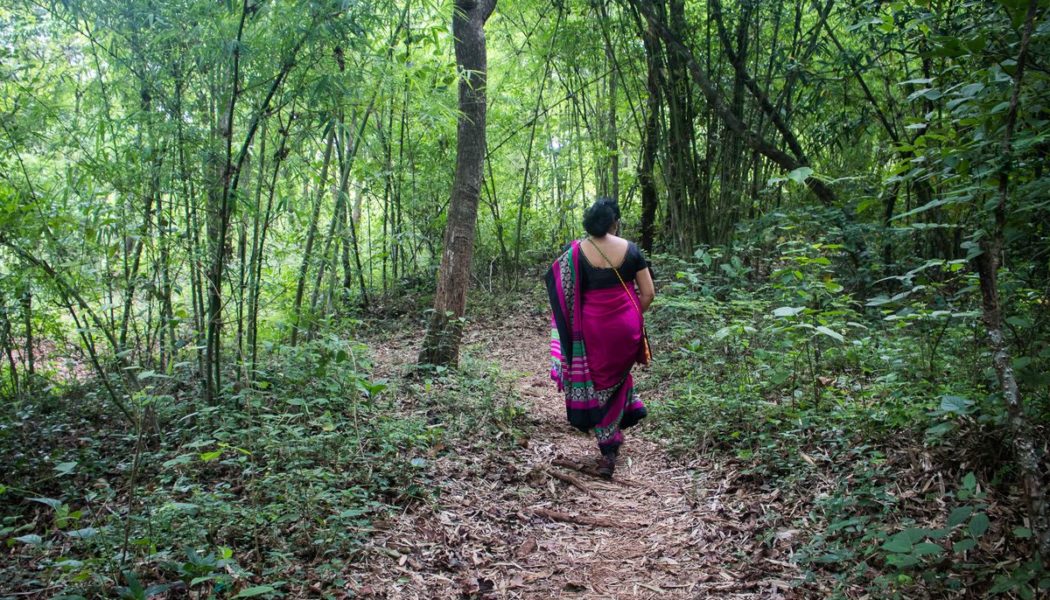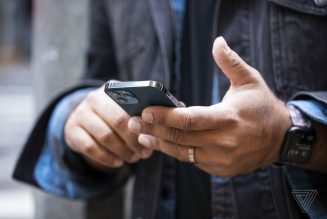Bharti Kamble is on the lookout for fake messages related to COVID-19. Late in the afternoon, she carefully reads over 500 messages from eight WhatsApp groups. As she finishes her search, she’s relieved. “For 30 days now, I didn’t come across a single piece of misinformation as WhatsApp forward,” she says. But after a year spent fighting misinformation, Kamble remains wary. “It’s still too early to declare a victory,” she says.
Kamble is an accredited social health activist (ASHA worker), the foot soldier of India’s rural healthcare system. When she started work as an ASHA, she never thought she’d be fact-checking hundreds of messages every week. Selected under India’s National Health Mission, ASHA workers are women who care for about 1,000 people within their village. They are tasked with at least 50 responsibilities, some of which include providing medicines for common ailments like coughs or fevers, maintaining over 73 different community health records, counseling on birth preparedness, ensuring antenatal and postnatal care, arranging for immunizations, providing contraception, and much more.
Kamble is the ASHA worker for the 701 people living in the remote village of Bolakewadi in Western India’s Maharashtra state. In some ways, they’ve been lucky during the pandemic — the village hasn’t reported a single COVID case. It is astonishing because over 50 percent of villagers regularly migrate 285 miles north to India’s financial capital Mumbai, a city that became a COVID hotspot.
:no_upscale()/cdn.vox-cdn.com/uploads/chorus_asset/file/22660962/VRG_4629_IMG_4888.jpg)
Starting in March 2020, nearly 1 million ASHA workers across 600,000 Indian villages were tasked with containing the community transmission of coronavirus. They survey their populations to find suspected COVID cases, monitor patients’ oxygen and temperature levels daily, contract-trace, ensure patients complete their quarantine period, and help them get medical care.
Their daunting task is complicated by misinformation, which spreads like wildfire on social media platforms. While surveying in March 2021, Kamble found a woman in her 80s with heavy fever and fatigue. “Why didn’t you take paracetamol tablets from me?” Kamble asked. The old woman replied, “What if you would have given my name to your seniors [supervisors], asking me to quarantine? I heard that fasting and praying to God alleviates the fever.” It was the third day of her fasting. Without any delay, Kamble gave her packets of Oral Rehydration Solution (ORS) and paracetamol tablets. “Within four days, she felt better,” Kamble said, but her task was far from over. Kamble began investigating and found that “fasting cures COVID” was a misinformation message forwarded multiple times in the vernacular language Marathi on village WhatsApp groups.
Kamble, who is a part of over eight such groups, immediately messaged that fasting is no cure for COVID-19. She explained the science behind a proper diet and the importance of modern medicines. She wanted to make sure that no one else tried to fast away a fever. “We didn’t get training on busting misinformation. We learned on the job and with interactions from the people,” she says. She may not have had any formal training, but Kamble’s had plenty of practice over the past year.
:no_upscale()/cdn.vox-cdn.com/uploads/chorus_asset/file/22660960/VRG_4629_IMG_4853.jpg)
Throughout the COVID-19 pandemic, India has tested positive for pseudoscience and misinformation, leading to a surge in cases. India reported over 29 million cases, with more than 353,000 people succumbing to the virus as of June 9th, 2021, with experts stating that this figure remains a massive undercount. Several leaders of the elected far-right Bharatiya Janata Party have been vocal about drinking cow urine to prevent COVID, with a few even making videos of it.
Last year, its leaders organized a gaumutra (cow urine) drinking event. Kamble came across several such messages. “What do you even say to something like that? A lot of people in fact did try it.” She started sourcing scientific messages from doctors and began messaging about COVID treatments that actually worked. “If you directly counter misinformation saying it’s wrong, then people don’t listen and start provoking you,” she explains. Instead, her antidote is disseminating scientific information in the easiest possible way. Eventually, she says, people realized cow urine is no cure for COVID.
Kamble isn’t the only ASHA worker using WhatsApp to curb misinformation. Netradipa Patil, an ASHA and leader of over 3,000 ASHAs from Kolhapur’s Shirol region, found that every family member in her surveying area of 1,000 people has at least one smartphone. “When we distributed COVID awareness pamphlets, people threw them [away]. That’s when I decided to act smartly.” When she saw instances of fake news and misinformation, she made a hyperlocal WhatsApp group with 200-plus members. “When unscientific messages go viral, I dial up at least three COVID doctors and confirm all the facts,” she says. She then types out messages, makes videos, and forwards newspaper clippings. This has taken a lot of her time but has helped save many lives. “In COVID’s second wave (March to June 2021), my area reported less than 10 cases and no deaths,” she says proudly. In contrast, Kolhapur district as a whole reported a case fatality rate of 3.5 percent in May 2021 — one of the highest in India.
:no_upscale()/cdn.vox-cdn.com/uploads/chorus_asset/file/22663699/VRG_4629_IMG_5097.jpg)
By June 2020, Patil had mobilized other ASHAs to form similar groups. In addition to combating misinformation over WhatsApp, they also make an effort to bust misinformation during their surveys of their community so they can reach people without internet access.
The situation became more urgent this spring. Starting on March 1st, 2021, India began its vaccination drive for citizens over the age of 60. ASHAs were to make a list of those citizens and submit it to the local civic authorities — but even gathering names became an uphill battle. “Senior citizens kept telling me that COVID vaccination is like slow poisoning. ‘Within six months of getting jabbed, we will die,’” Patil said. The misinformation that “India’s population has increased a lot and the Government is using vaccines to reduce it” spread rapidly. “It sounds funny, but it took two months of messaging and door-to-door visits to convince more than 90 percent of people to get vaccinated,” she recalls. Patil also shared her photo of getting jabbed and said, “I’ve taken both the doses, and I am alive.”
Even after people get vaccinated, the job of ASHAs doesn’t end. In Kolhapur’s Pernoli village of 2,265 residents, two people died within a few days of the vaccination. This was a nightmare scenario for ASHA workers Mandakini Kodak and Rekha Dorugade. Suddenly, everyone in their village resisted vaccination. They probed these deaths and found both people were asthmatic and COVID positive — and that they hadn’t received reputable care. “They took injections and medicines from a quack. How can someone blame the vaccines then?” asks Kodak.
:no_upscale()/cdn.vox-cdn.com/uploads/chorus_asset/file/22660958/VRG_4629_IMG_4805.jpg)
Often, misinformation is intertwined with superstitious beliefs. “Last year, several villagers refused to follow COVID protocol, saying that the village God won’t let Corona in,” remembers Kodak. Kamble faced something similar. As COVID cases kept increasing across the hinterlands, several villagers decided to swarm the local temple for a “community prayer.” Kamble started messaging that even if a single person tests COVID positive, it could lead to community transmission. She put infographics of COVID protocols as her WhatsApp status. “Faith is completely fine, but when it overpowers logic and science, it becomes a problem,” she says.
ASHAs work in stifling conditions with inadequate safety gear and receive “performance-based incentives” based on the tasks completed. Despite working for over a decade, they aren’t recognized as full-time workers and average a monthly pay of $41 to $55 in Maharashtra. “We are busting misinformation, saving countless lives, and completing surveys on phones, yet the Government doesn’t even reimburse us for the internet,” says Patil. With poor pay, many ASHAs double up as farmworkers to make ends meet.
Their limited resources aren’t well-understood in the communities they serve. Last year, a rumor began circulating on WhatsApp that said that for every COVID-19 patient detected, the Central Government would send money to local governments, Kodak says. This was not true. “The Government has no money to even buy hand gloves and sanitizers for us, how and why will they spend on detecting cases?” asks Kodak laughingly.
The ASHAs’ mission to contain COVID-19 outbreaks is often hampered by their poor-quality oximeters and infrared (IR) thermometers, provided by the government. While surveying, Maya Patil, an ASHA from Shirol, found her oximeter wouldn’t show any readings. There were problems with the oximeter’s display and quality. “It would show a reading only when indoors. Surveying inside the houses of containment zones with inadequate ventilation means risking life, but the Government doesn’t understand this, and [it refuses to give] us better-quality equipment,” she says. As a result of the faulty readings, many people refrain from getting their oxygen levels tested. “Many lives will be at risk if there’s a community transmission because of faulty equipment,” says Maya Patil.
:no_upscale()/cdn.vox-cdn.com/uploads/chorus_asset/file/22660959/VRG_4629_IMG_4850.jpg)
Kamble experienced a similar problem from a 72-year-old woman. “Her oxygen level had dropped to 70. The family didn’t believe it and started verbally abusing me,” she says. The family started accusing Kamble of planning a conspiracy to send the old woman to the quarantine center. Somehow, she persuaded the family to consult a doctor. The patient’s oxygen level was diagnosed to be lower. “Less oxygen doesn’t always mean COVID, and people don’t even know what the normal oxygen level is,” Kamble says.
To educate the community and regain their trust, Kamble turned again to social media. She found a graphic representing the required oxygen level and put it up as a WhatsApp status. She sent the same photo to multiple WhatsApp groups, eventually reaching over 500 people directly.
“My inbox was flooded with replies, with some mentioning they had taken a screenshot as a reference, while others thanked me for making them aware of it,” she says. “The same family now asks me to monitor the oxygen level daily.” For something as simple as checking oxygen, Kamble was forced to spend several hours working to counter misinformation on WhatsApp. Now, she is facing off with senior health officials regarding the mediocre-quality equipment. Already, she has gotten several of her oximeters and IR thermometers replaced.
It’s one of the triumphant stories ASHAs share about countering misinformation using technology. “There are many people who thank us for asking them to get vaccinated,” says Kodak. While some people in the area tested COVID positive, none were hospitalized, vindicating the ASHAs’ vaccination campaign. “It’s refreshing to listen to such stories.”
“Even if people disagree with our messages, they do read and discuss. While surveying, we spend at least three hours every day countering such misinformation,” Kamble says. While misinformation in her own village has slowed, the list of pseudoscientific messages continues ricocheting around WhatsApp groups in other areas of the country.
“One shouldn’t take a vaccine while menstruating”
“If you have taken the vaccine, you should avoid sunrays for a week”
“Snorting camphor powder increases your oxygen level.”
“Onion eaten with rock salt keeps away Corona.”
These are just a few of the hundreds of messages Kodak has received lately. She addresses every statement, often while working 10- to 12-hour days. “If I save someone, I will have done my job,” she says.
Photography by Sanket Jain










